The Google Nexus 6P Review
by Andrei Frumusanu on December 16, 2015 8:00 AM ESTBattery Life
Battery life on the Nexus 6P will be a quite interesting story. On one hand we have a very large 3450mAh battery, but on the other hand we have an AMOLED screen that is less efficient than most LCDs, all of which is driven by the Snapdragon 810, which trails in efficiency. Due to the Note 5 and Mi Note Pro both sharing the same form-factor and a 5.7” 1440p screen, they present perfect comparison devices that isolate either the screen advantage or disadvantage (Mi Note Pro) or the SoC differences between the devices (Note 5).
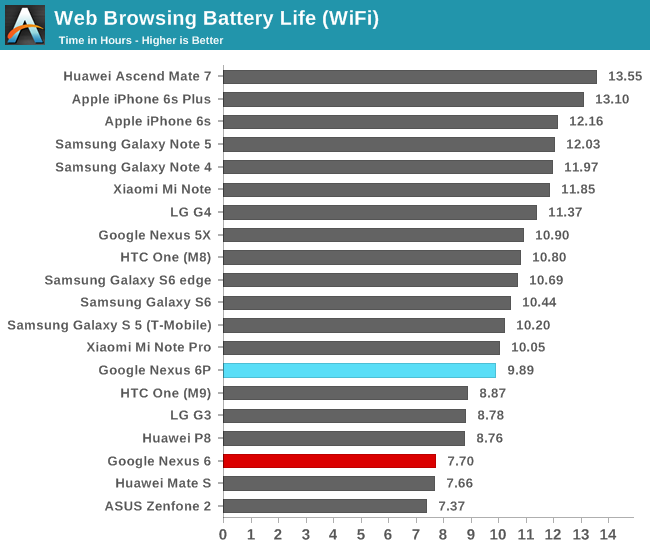
We start with our web-browsing battery test. Here we see the Nexus 6P reach 9.9h of runtime. While by itself this doesn’t represent a very bad figure and most people would be able to make do with such a number, when comparing it to other devices it represents a quite disappointing performance as the increased battery size doesn’t seem to give the 6P any advantage. The 6P reaches same battery figure as the Mi Note Pro which sports a smaller 3090mAh battery (11% disadvantage). As both devices sport the same SoC, any difference in the web browsing test is most likely due the power efficiency disadvantage of the AMOLED screen on the part of the 6P.
On the other hand if we want to look at the difference in efficiency of SoC, we can use the Note 4 as a relatively fair comparison. The Nexus 6P sports a screen that is ~5% more efficient and has a 7% advantage in battery capacity, yet it manages to fall behind the Note 4 with Snapdragon 805 by 16%, or almost 2 full hours.
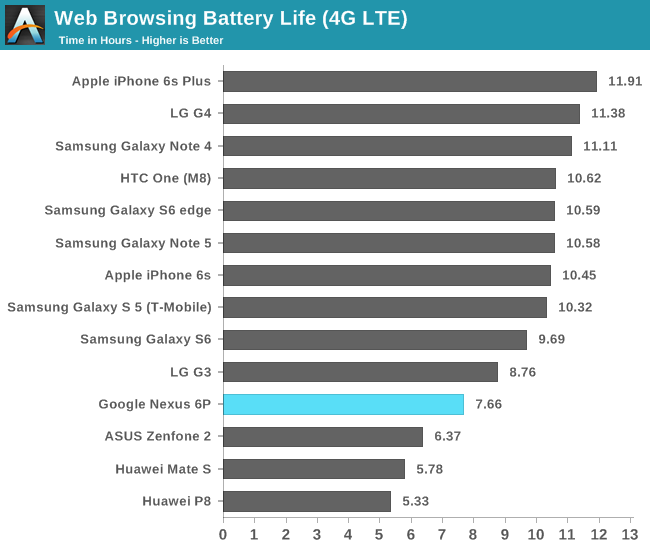
On the 4G LTE test, as with other reviews in the past I have to warn that I have worse cell network signal conditions compared to our other mobile reviewers Joshua Ho and Brandon Chester, making this not a fully accurate apples-to-apples comparison in terms of testing conditions. Keeping that in mind, we see the Nexus 6P also struggle to compete with the other devices in our results database.

PCMark’s battery life test is a more balanced workload that compromises of more real-world use-cases. Due to the test also having a lower average picture level (darker contents), the AMOLED screen is able to regain competitiveness against the Mi Note Pro. Again, mostly due to the efficiency disadvantage of the SoC, the differences between the Nexus 6P and the Note 5 remain large in this test as the former manages to last almost 1.5h longer even though the 6P has a 15% larger battery. Disregarding the competition, the 6P still manages to show some good battery scores in this test, although we do have some concerns over the performance demonstrated in the writing-subtest.

BaseMark OS II’s battery test is a very heavy CPU test that if more of a sustained performance and overall device TDP benchmark. Here the Nexus 6P lasts a little over 4 hours. As we’ve seen in the device thermals section from earlier, there’s a significant difference in long-term performance between devices even if they sport the same SoC.
How long a device can last in such a heavy load test is thus mostly a function of the thermal settings of the device, which does not give any good indication of the overall efficiency of the device. For example a given device can end up with a low battery runtime, but may have actually have better efficiency than one with higher battery runtimes. This rule is generally limited to synthetic scenarios as real-world scenarios where a device is thermally limited are generally rare.
Again for this review I feel I need to go a tangent to better explain why the Nexus 6P ends up with the battery life it has. The Snapdragon 810 and 808 unfortunately suffer from exceptionally bad efficiency that affects most of this year’s devices, Nexus 6P included. As we can see in the above graph, both SoCs exhibit worse performance/W efficiency than last year’s Snapdragon 800 series (805 included). For the Nexus 6P this is especially worrying as it would mean the device is actually less efficient than the Nexus 6 when it comes to computational loads. Unfortunately it seems that this year Samsung is alone in being able to showcase an improvement over last year’s devices courtesy of the Exynos 7420 enjoying a 2-3x lead in power efficiency over this year's competing high-end SoCs.
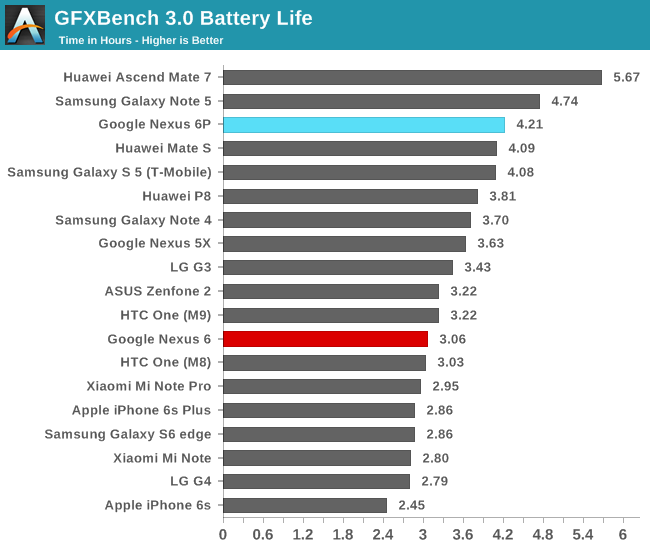
Lastly on GFXBench, the Nexus 6P ends up with 4.2 hours runtime on the on-screen battery test. This is a good result for the phone, even though it’s required to throttle to about 50% of its peak performance for most of the duration of the test to maintain reasonable skin temperatures. Here Qualcomm still has a considerable advantage over ARM’s Mali GPUs so that the Adreno 430 still is very competitive even though it has to deal with a process node disadvantage. It will be definitely be interesting to see how the Snapdragon 820’s Adreno 530 will be able to shake up the field.
Overall, the Nexus 6P offers what one would subjectively call good battery life. The large battery largely makes up for any SoC inefficiencies and we’ve even seen that the AMOLED display is near being on par with LCD’s power efficiency. If I seem a bit harsh it’s because I cannot shake the feeling that had the Nexus 6P come out with either the Snapdragon 805 or 820 we’d have seen much better battery figures more in line with the Note 5.
Charge Time
The Nexus 6P ships with a 3A@5V charger. The charger uses a USB Type-C connector, so you need a Type-C to Type-C cable to be able to charge the device. The Nexus 6P does ship with one out of the box, but I question Google’s decision as it would have been much more practical to receive a more traditional USB A to USB C cable to allow the Nexus 6P to charge from existing sources without having to buy an additional cable (technically the 6P does also come with such a cable, but at only about 15cm in length it’s very impractical).
The Nexus 6P along with the 5X are some of the first devices to come with USB Power Delivery 2.0, the official specification for device charging as opposed to more proprietary charger communication protocols such as those from Qualcomm (Quickcharge) or Adaptive Fast Charging that is used in Samsung chargers.
What seems to be interesting about the charging behaviour is that there’s visibly more charging “steps” than other devices. The period that is usually called the fast-charging phase of the charging cycle runs up to 40% battery capacity. Here the battery cell receives up a bit over 12.5W of charge power, after which it steadily reduces the input current until it enters another charge pattern from 50 to 80% coming in at around 10W. Finally at 80% the device switches to trickle-charging as the input current exponentially decays over time.
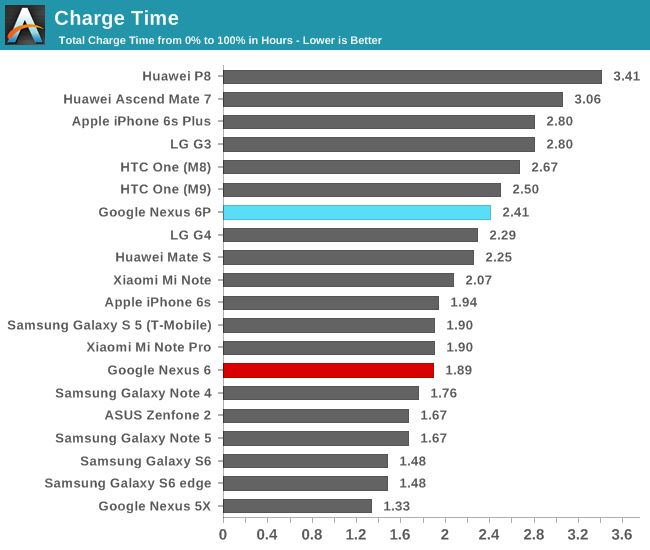
What is worrying is that the battery charge indicator is extremely inaccurate at high charge levels. The device reports 100% much earlier than other devices. In fact there’s still over 2W of power coming into the battery as it reports being fully charged. This goes on for another 40 minutes, representing an actually significant amount of energy representing about 7% of the battery’s true capacity. As such, the Nexus 6P doesn’t receive a good grade in the charge time metric due to its misleading charging indicator behaviour.
Nevertheless, it’s able to charge from 0 to 40% in 30 minutes which is outstandingly fast. 45 to 80% takes about an equal amount of time which means for the large majority of use-cases where you are in desperate need of power the Nexus 6P will be able to serve you well (As long as you have your charger and cable with you).


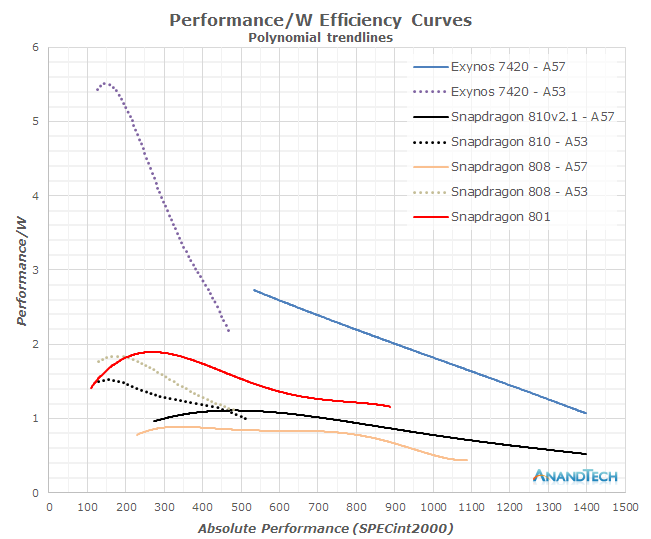
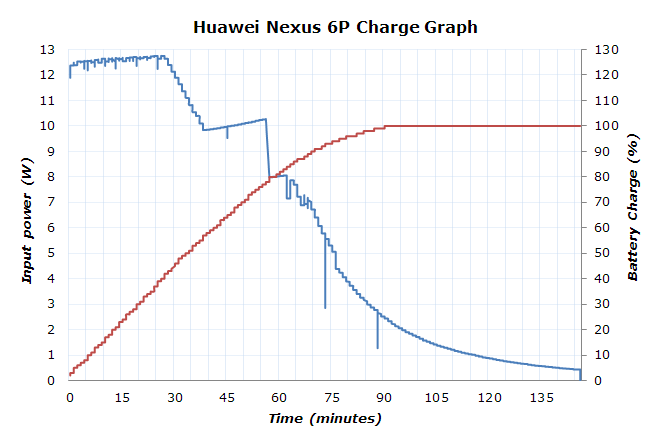








219 Comments
View All Comments
hfm - Thursday, December 17, 2015 - link
Muscle memory is easily learned in short order. Took me a week or two switching from two years of an N5 to get used to the differences. I always ignore those parts of reviews unless it's an obvious exceptionally bad UX choice. These weren't.Nightfall983 - Wednesday, December 16, 2015 - link
I don't understand your need about stock Android not having brightness slider in the notification shade. Swipe the shade down with 2 fingers (or pull down twice), and is right there.hfm - Thursday, December 17, 2015 - link
Not to mention turning off adaptive brightness will get the phone to 500 nits. I leave it on though.. But for this review where numbers are thrown around it should have been done.ChronoReverse - Wednesday, December 16, 2015 - link
Hi Andrei, nice review. You may want to explore /system/etc/thermal-engine.conf to see how the software level thermal throttling is configured. It's pretty interesting how core shutdown and frequency limiting is configured with respect to the temperature. Interestingly enough, GPU throttling is tied to the main temperature sensor as well.You can even remove the file so that the phone relies solely on the fail-safe thermal throttling.
Jeff7181 - Wednesday, December 16, 2015 - link
Would have been nice to see the OnePlus phones in these benchmarks... especially battery life.GPz1100 - Wednesday, December 16, 2015 - link
How about the review including some details on phone call quality, signal reception, etc...?QinX - Wednesday, December 16, 2015 - link
Why? Who uses a phone to call someone and expect a clear reception these days?mystilleef - Wednesday, December 16, 2015 - link
I have both the Note 5 and the 6P and there is no way in hell I'd recommend the Note 5 over the 6P on any universe. The 6P has better battery life, better speakers (yes, contrary, to the reviewer, front facing speakers make a huge difference), better camera (especially low light indoor shots), better MEMORY MANAGEMENT, a better OS, and just a far better user experience.Anyone telling me TouchWiz is better than Stock Android is just delusional. I can't take that person seriously, and I don't think anyone should. TouchWiz has horrible, horrible, horrible memory management especially on the S6 and Note 5. If you enjoy your browser tabs and apps reloading every time you blink, or you fancy random crashes due to memory mismanagement, get the Note 5.
Yes, I own the Note 5, and used it exclusively before I got the 6P.
The ONLY thing great about the Note 5 are the camera and display. That's it. TouchWiz is a curse to Android so much so that there are rumors that Samsung is in talks with Google to help them fix, or optimize, TouchWiz.
I choked on my food when Andrei recommended the Note 5 over the 6p for non-US users. Are you serious, Andrei? Did you use the Note 5 for any extended period of time? The only way I can recommend the Note 5 is if you're willing to flash CM on it.
The Note 5 has been one of the most unstable and unreliable Android devices I've ever used. I regretted selling my Nexus 6 for it. I read all the hype here and on the Internet about the Note 5 and fell for it. As a matter of fact, I plan on getting a Nexus 6 as a backup device and using it instead of the Note 5. Heck even the Nexus 6 performs better than the Note 5, and no one can convince me that TouchWiz is not the culprit.
In what universe is TouchWiz a better user experience than stock Android? Slide down the notification drawer on your 6p and do the same on your Note 5, that's all you need to know about the user experience of either devices. And I'm not even going to talk about the stutter and lag that begins to creep in after a few days of using any TouchWiz device.
I enjoyed the review, but sheesh, it's hard for me to trust the taste or opinion of anyone recommending TouchWiz over stock Android. That, unfortunately, tainted the review for me. A review I'd have otherwise held in high regard.
VnnAmed - Wednesday, December 16, 2015 - link
And if you need to flash CM on Note 5 remember that you will trip KNOX. Or just staywith N6P and flash away since their warranty is not bootloader state dependent. @Andrei Frumusanu One thing that this review didn't mention is that Nexus devices are flash friendly. Why would I buy one of those if not for long-term support and ability to change ROMs? And I understand that these articles are for normal people, but are they now? I'm classified as a nerd by fellow humans and even I don't understand every aspect of this review. Especially the screen part gets me confused BTW but back to the point, you said that you don't like where the back button is. Well most ROMs will have an option to change that, heck even a ROM for my M7 has it. Buying a Nexus phone is entering into the world of customization especially because these phones are semi-development devices. So while this is a review I've been waiting for and it's actually more beefy than I expected (good, I like them beefy reviews) especially in the hardware department, it falls short when explaining why would one pick Nexus over some other device. And my answer to that is it's because of freedom to change most of the settings just by typing few lines of code. And even if like me someone is not very good at that there are thousands of devs that do it everyday and allow us puny humans to download their work for free. So in the end just a short comparison from the other side of the fence. I live in Europe too. And it's not the nice and rich western Europe either. I'm poor and poor tech enthusiasts can't allow themselves to throw money around. So if I am faced with a choice between S6 and N6P I will with certainty choose the latter. Why you may ask? Because I will happily use Android 8 or whatever while Samsung will say something like "you want new Android on S6? We're sorry, we can't pull miracles with these puny 3 gigs of RAM". And when S6 will be stuck on some buggy release of Android 7.1.2 I will be flashing Official Exodus ROM Android 9 for Angler. Because even if google falls short, devs rarely do, and that's the true power of a Nexus device. P.S. Remember N4? It has fully working AOSP marshmallow.phoenix_rizzen - Wednesday, December 16, 2015 - link
Just curious why you specify the wireless as being dual-band, when it's more than implied by the standards supported.802.11b and 802.11g are 2.4 GHz only. 802.11a and 802.11ac are 5 GHz only.
Thus, listing 802.11a/b/g/n/ac support means it's dual-band, 2.4 GHz and 5 GHz. It can't be anything else.
If it only supports 802.11n (or 802.11b/g/n), then it makes sense to specify whether it's 2.4 GHz only, or 2.4 GHz and 5 GHz, as n works in both bands.